Unless you’ve been living under a COVID-proof rock, you already know that more people than ever are working from home.
But the pandemic isn’t the only force at play here. We’ve been headed towards more remote work for a while. According to a 2014 survey, 34% of company executives said they expected over half their workforce to be remote by 2020.
And they weren’t wrong.
Due to the global pandemic and sudden office closures, it was a shift that happened almost overnight. By the end of 2020, 71% of employed Americans who could do their jobs remotely were working from home.
Now, as we enter 2022, return-to-office plans are being finalized and employees are being summoned back to their desks. But who’s to say back to the office is best?
To understand how employees feel about working remotely, we surveyed 400 people who performed their full-time job from home during the past year. Prior to moving to remote work in 2020, all of our respondents primarily worked in an office environment.
We asked them about their experience shifting to remote work and how their productivity, happiness, and social connections differ now compared to when they worked in the office. Here’s what they said.

Employees feel more productive working from home
We asked employees if they are most productive in the office or at home. The majority say they do their best work remotely.
63% of employees are more productive working from home.
37% of employees feel they get more done in an office.
Create videos that drive action
Activate your customers or team with impactful, on-brand videos.
Remote work doesn’t mean less work
We asked how many hours employees spend on actual work when they are at home vs. when they are in the office.

When working from home, the majority of employees (29%) spend between 7 to 8 hours per day on work.
When working in the office, the majority of employees (38%) say they spend between 5 to 6 hours per day on work.
Overall, employees are less likely to work a full 8 hours from the office (12%) than they are from home (14%).

Remote meetings aren’t so bad
Zoom meetings get a bad rap, but our respondents prefer video calls over in-person meetings.
54% of employees prefer meeting a colleague via video call.
46% of employees prefer in-person meetings.
What comes to mind when you think of a Zoom meeting?
According to our respondents, it’s a mixed bag.
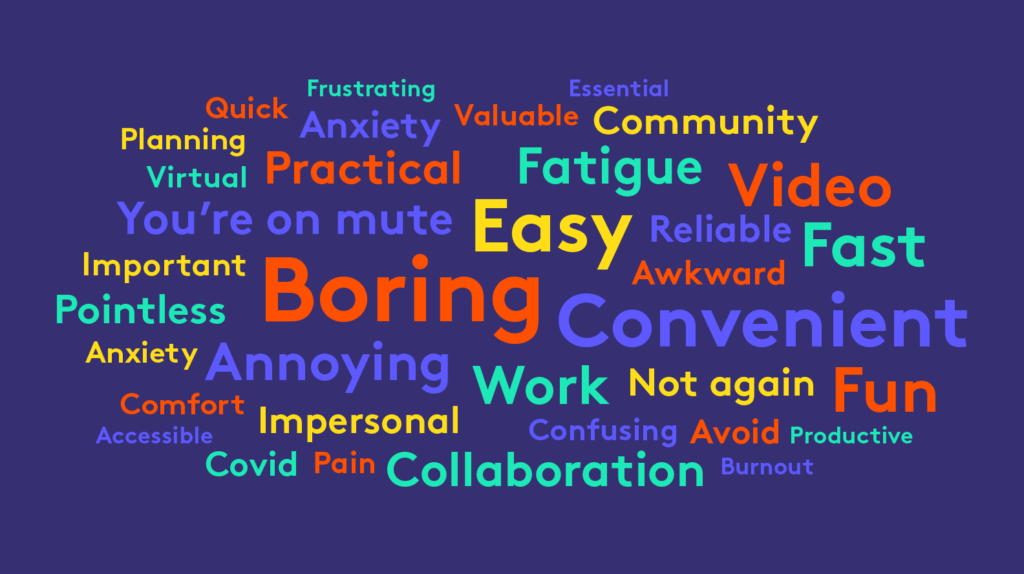
Remote workers miss the social aspect of the office
We asked if employees miss the social aspect of the office when working remotely. Most said yes.

80% of remote employees miss the social aspect of the office.
20% of remote workers don’t miss the office social scene.
27% of remote employees miss the social aspect of the office, but not enough to return.
They also miss work-related social events
We asked remote employees if they miss attending office social events while working from home. Most said yes.
68% of remote employees miss work-related social events.
32% of remote employees don’t miss work-related social events.

Most employees are happy working from home forever
We asked if remote employees would like to work from home forever. The majority would be happy without the office.
62% of remote employees say they’d be happy to work from home forever.
38% of employees currently working from home would be unhappy doing so forever.
A flexible, hybrid work arrangement is ideal for most
We asked remote workers about their ideal balance between working in the office and working from home. The majority prefer a mix of WFH and working from the office.

50% of employees say they’d like to spend 2 or 3 days in the office per week.
13% of employees say they’d like to work entirely from home.
11% of employees say they’d like to return to the office full-time.

Remote work brings families closer
We asked remote employees if working from home puts a strain on their family relationships or if it makes them closer. Most say remote work has a positive impact.
45% of employees say working from home made their family closer.
17% of employees say remote work put a strain on their family relationships.
38% of remote workers say working from home hasn’t made a difference to their family relationships.
Perceptions of remote work differ around the world
We surveyed remote employees from four countries — the USA, Canada, Australia, and the UK. The results led to some surprising observations.

UK employees want to spend the least amount of time in the office (2 days per week). As a whole, respondents prefer 3 days per week.
Australians are the least happy about the prospect of working from home forever. Only 53% would be happy doing so, vs the average 65%.
UK and Australian workers prefer in-person meetings (57% and 59% respectively.) US and Canadian workers prefer video (73% and 58%).

Gender impacts the strain of working from home
Men and women feel the effects of working from home in different ways.
The majority of women (49%) say working from home hasn’t made any difference to their family relationships.
The majority of men (47%) say working from home has brought their family closer together.
Married people work longer hours from home
Marital status changes how likely respondents are to work long hours at home.

Married people report working more hours from home (7-8 hrs/day) compared to their single counterparts (5-6 hrs/day).
Married people work longer hours at home (7-8 hrs/day) than they do in the office (5-6 hrs/day).
Single employees report working the same number of hours whether at home or in the office (5-6 hrs/day in either location).
Appendix: Survey graphs
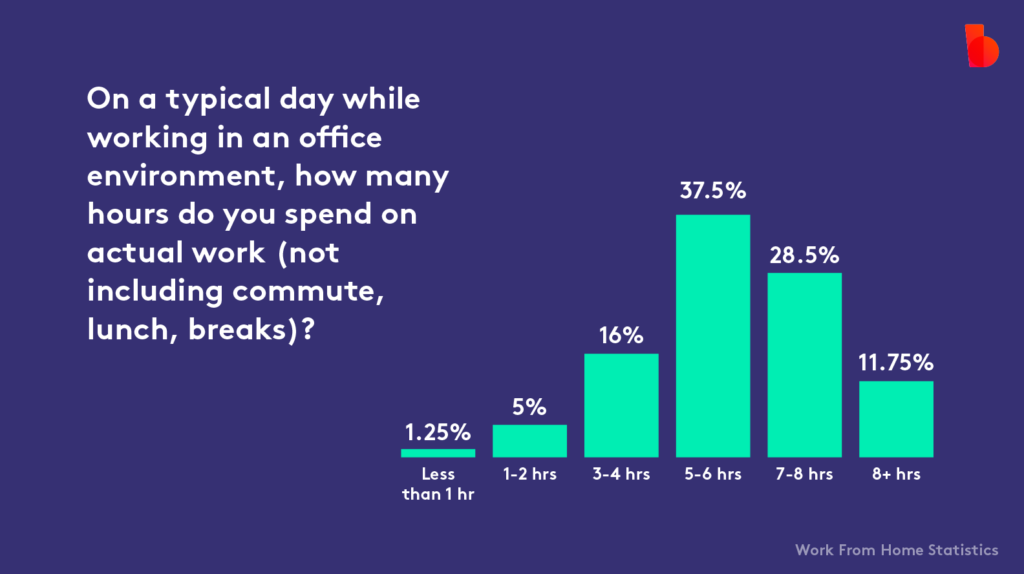
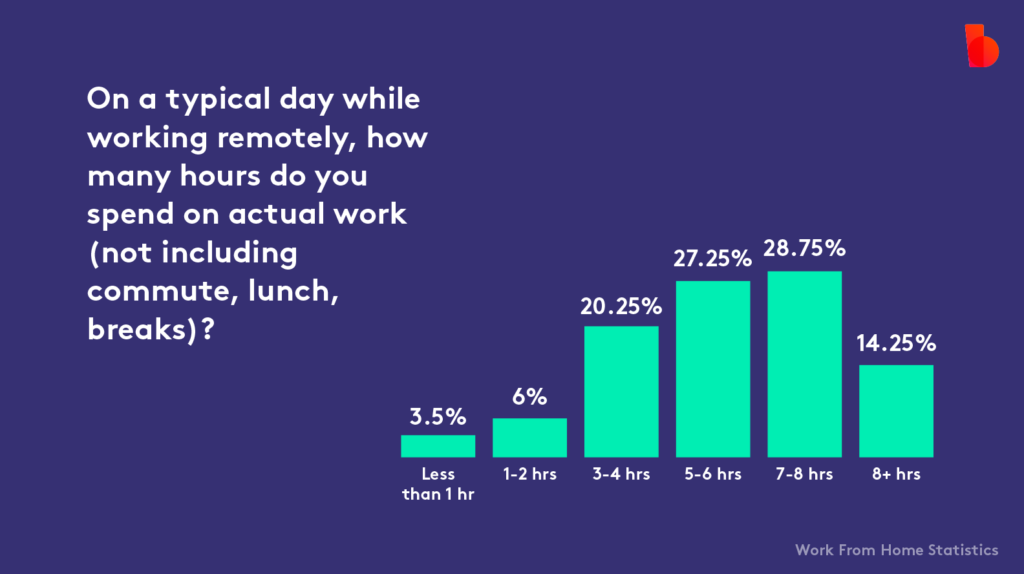
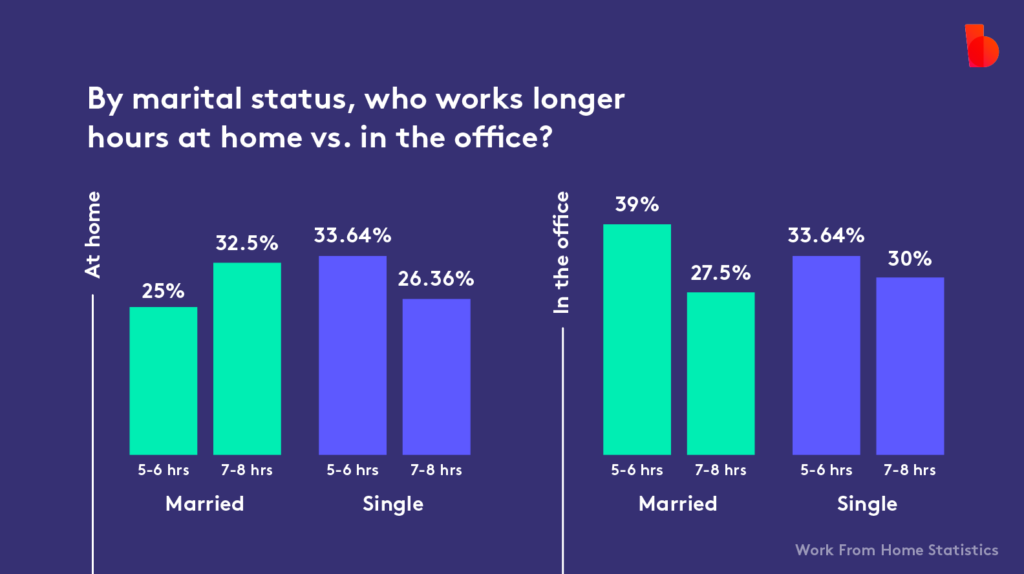

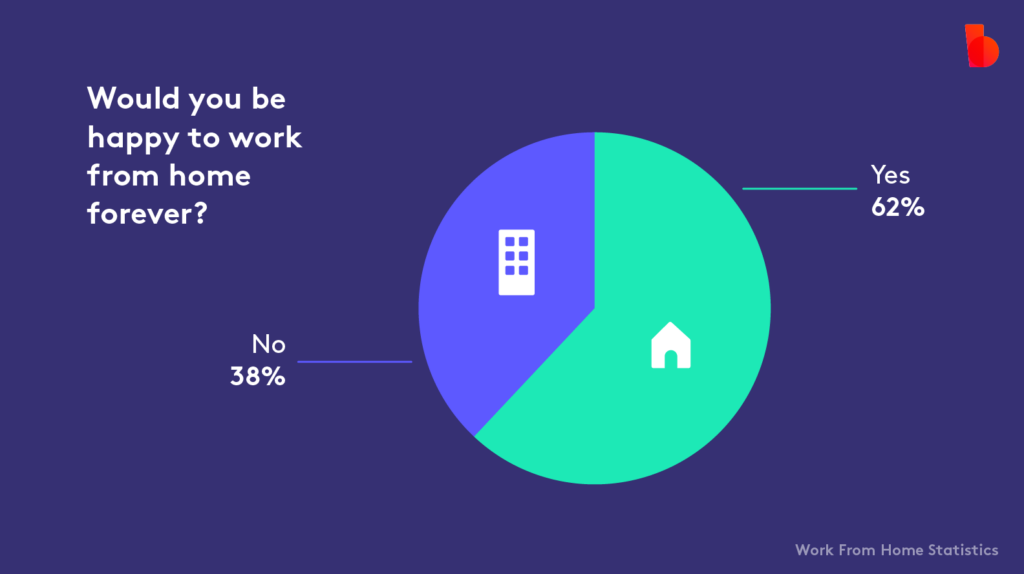
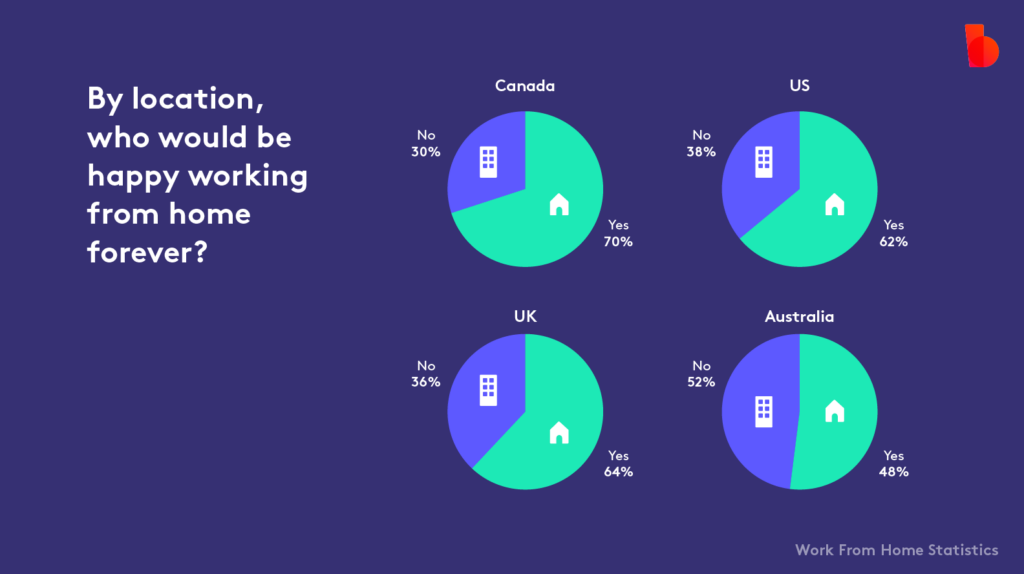
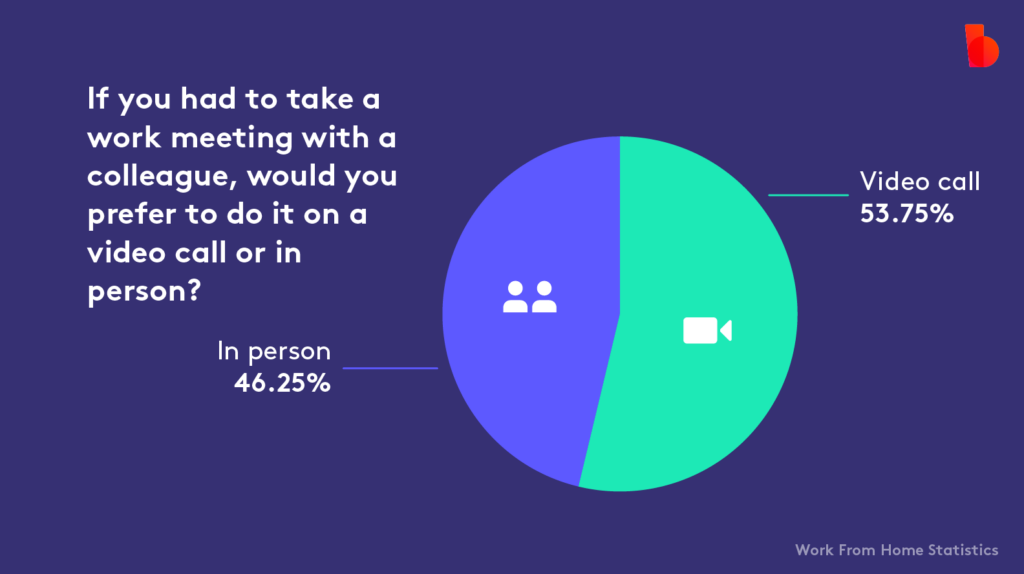

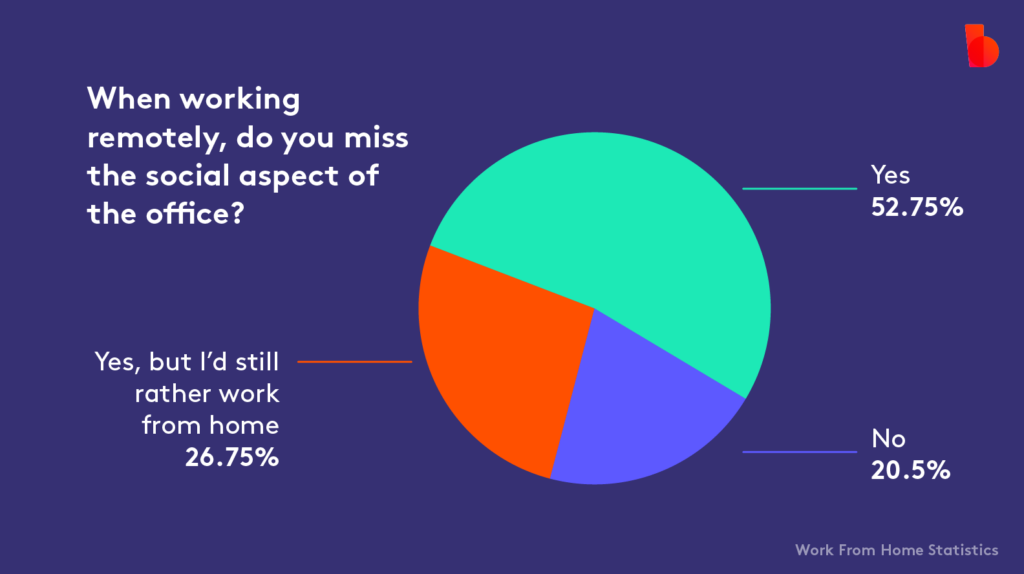
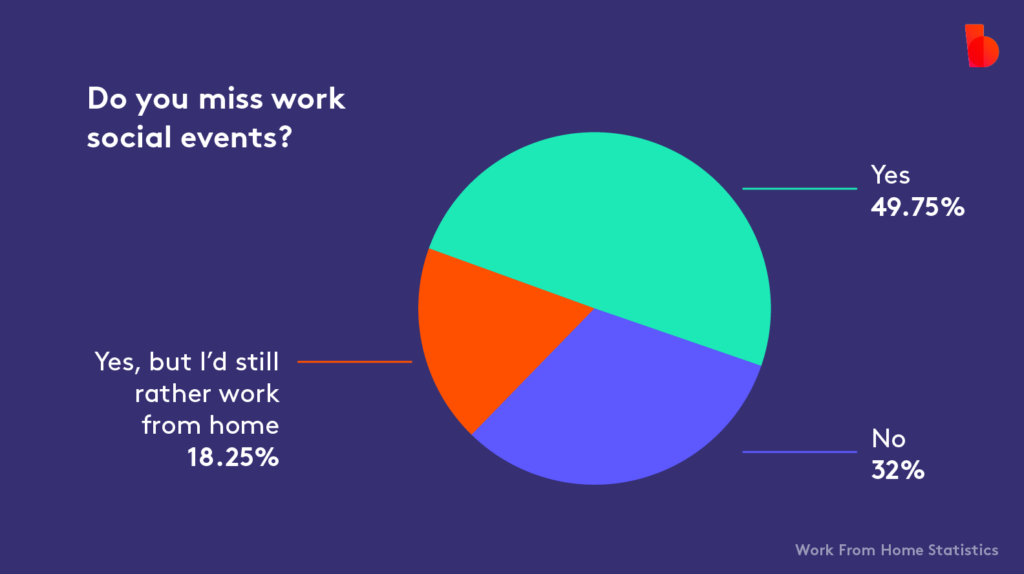
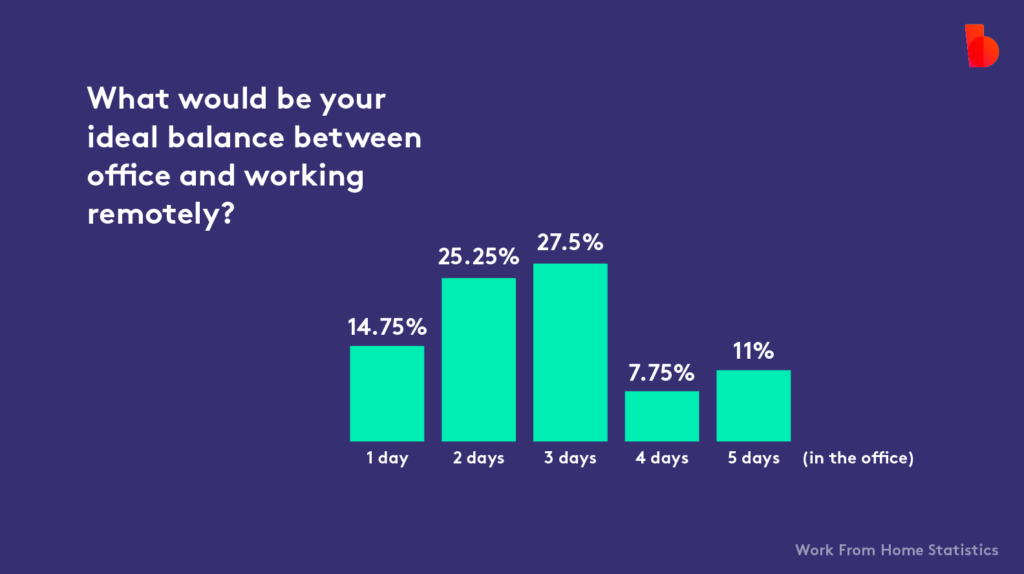
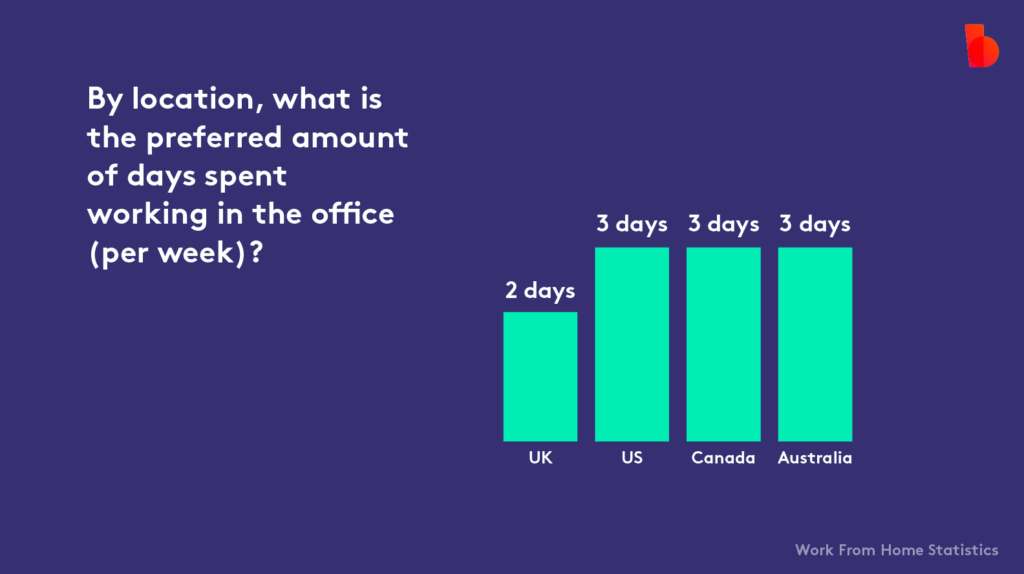
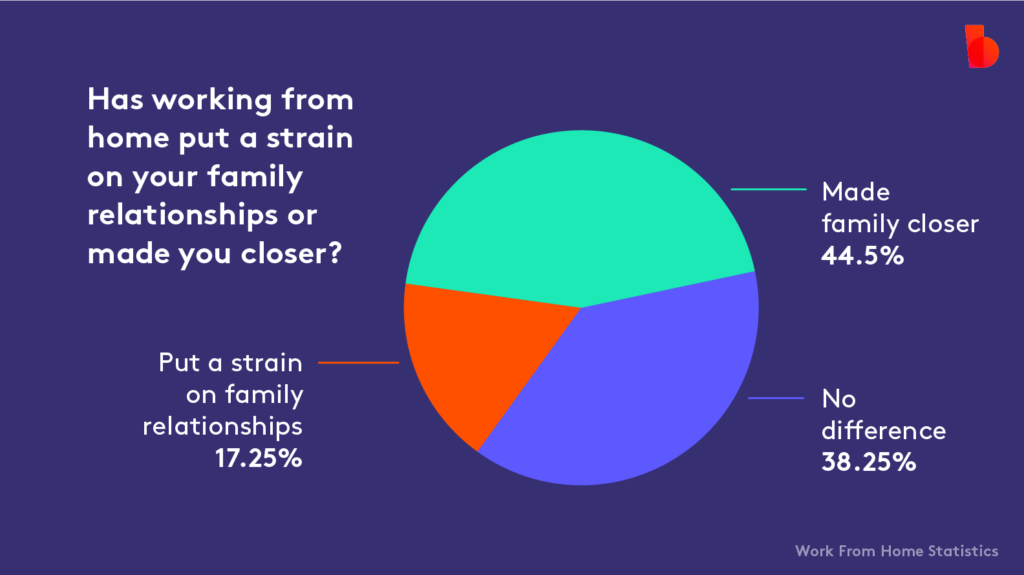

Even more remote working statistics
That’s all for the Biteable stats. But we’re not the only ones thinking about remote work these days. There are a whole lot of other work-from-home statistics available from thought leaders around the world.
After we finished our own survey, we did a deep dive into the existing data to discover valuable insights about the future of both traditional and remote work.
We hope these statistics give you a clear picture of what remote work looks like, what employers can do to help their WFH employees thrive, and how companies can succeed in the new world of work.
Statistics on the future of the office
Remote work is here to stay. Many jobs can be done from home, and massive swaths of the workforce are already working remotely. The majority of work-from-home employees would prefer to stay remote indefinitely, at least a few days a week.
As the great, global WFH experiment continues, one thing is clear: the future of the office looks a lot different now than it did pre-pandemic.
- 58.6% of the total U.S. workforce was working remotely at the end of 2020 (Upwork).
- 71% of U.S. employees who say their job can be done from home are already working remotely (Pew Research).
- 50% of the global workforce works from outside the company office at least 2.5 days per week (IWG).
- 62% of businesses around the world have a flexible workspace policy (IWG).
- 16% of companies in the world are 100% remote (Owl Labs).
Many believe this trend will continue.
- 70% of people say they believe workers will never return to the office at pre-pandemic rates (BBC).
- 92% of employees expect to continue working from home at least one time per week and 80% of employees expect to do so at least three times per week (Owl Labs).
- An estimated 73% of all departments will have remote workers by 2028 (Fundera).
Labor statistics support this theory.
- 37% of jobs in the U.S. can be done remotely (National Bureau of Economic Research).
- About 4 of 10 workers say their jobs can mostly be done remotely (Pew Research).
For the majority of employees, this trend toward remote work is welcome news.
- Over 97% of remote employees say they would like to continue working remotely, at least part-time, for the rest of their career (Buffer).
- 98.3% of remote workers would recommend working remotely (Buffer).
- 56% of women and 52% of men would like to indefinitely work from home all or most of the time (Pew Research).
But not everyone agrees.
- 44% of companies in the world don’t allow any remote work (Owl Labs).
Stats on remote work, productivity, and the bottom line
Remote work isn’t just good for employees; it also has a positive impact on the bottom line. According to recent work-from-home statistics, remote work is more cost-effective for employees and businesses alike.
This gives companies strong incentives to adopt or expand their remote workforces, and pretty much guarantees remote work will enjoy a place in the global landscape for the foreseeable future.
Productivity improves with remote work.
- 94% of employers report that productivity has been the same or better since implementing remote work (CNN).
- The highest percentage of productive employees in 2019 (before remote work) was 79%. The highest percentage of productive employees in 2020 (after remote work) was 87% Great Place to Work).
- 76% of employees avoid the office when they need to get important work done (Atlassian).
- Increased productivity isn’t the only area where companies benefit.
- Employers save an estimated $11,000 per year for each half-time remote worker and $22,000 per year for each full-time remote worker (Global Workplace Analytics).
- Companies report increasing profit by as much as $2,000 per remote employee after transitioning to a remote workforce (Stanford).
- 79% of employees are willing to take some degree of a pay cut to work from home (Owl Labs).
Remote employees see significant savings as well.
- Half-time remote employees save between $600 and $6,000 per year in commuting costs, after accounting for home energy and food Global Workplace Analytics).
- Remote workers save an average of $4,523 per year in fuel alone (Airtasker).
- Half-time remote employees save 11 workdays per year in commuting time (Global Workplace Analytics).
- Full-time remote workers save 17 workdays per year in commuting time (Airtasker).
Some companies appear to be passing a portion of their own savings on to their remote employees.
- On average, remote employees get paid 8.3% more than non-remote employees with the same qualifications and job title (PayScale).
The work-from-home employee experience
Not only are remote employees less expensive and more productive, but if work-from-home statistics are to be believed, they’re happier too. Here’s what we know so far about the remote employee experience.
Overall, remote workers report a positive employee experience, job satisfaction, and work-life balance.
- 57% of remote employees say they are satisfied with their jobs, compared to 50% of in-office workers who report job satisfaction (Flexjobs).
- 75% of employees who work remotely say they are well situated to work from home (Pew Research).
- 66% of employees who have transitioned to remote work say their work lives are about the same as before they transitioned to remote work (Pew Research).
- 30% of employees say they are more engaged in their work when working from home (Becker Friedman Institute).
- 65% of remote workers say remote work has positively impacted their work-life balance (LiveCareer).
- Remote employees exercise 25 minutes more each week than non-remote employees (Airtasker).
Remote work affects employee relations, too.
- 68% of hiring managers report that remote work is going more smoothly now than when they first transitioned (Upwork).
- If offered the chance to work remotely, 80% of employees would feel like their employer cares (Owl Labs).
- 66% of remote employees report they would be less happy if they were no longer allowed to work from home (Owl Labs).
- Of those same employees, 54% would be less willing to go the extra mile. (Owl Labs).
But it isn’t all sunshine and rainbows.
- 43% of employees worry that working remotely will impact their career progression (Owl Labs).
- 50% of remote workers say they don’t get as much feedback as they did when they worked in the office (LiveCareer).
- 78% of remote employees would like more training from their employers (TalentLMS).
Many employers already recognize the need for more change.
- 33% of employers are actively considering employee experience as a clear mandate at the C-suite level, largely as a result of the pandemic’s effect on the workplace (Gallagher).
Remote work struggles
There’s a lot of good news when it comes to remote work. But it’s not all good news. For many companies, moving to a remote workforce brings up new struggles that weren’t an issue in the traditional workplace.
Security is one major concern.
- 90% of IT professionals believe remote work poses a security risk (OpenVPN).
- 54% of IT professionals believe remote workers pose a greater security risk than onsite employees (OpenVPN).
And many remote workers struggle with at least some aspects of working from home.
- 42% of remote workers younger than 50 say they struggle with feeling motivated to do their work (Pew Research).
- 38% of remote workers younger than 50 say they struggle to get their work done without interruptions (Pew Research).
- 50% of parents who work remotely say it’s difficult to work without interruptions (Pew Research).
- About 4 in 10 mothers say it’s now harder to balance work and family responsibilities (Pew Research).
- 27% of remote employees say their biggest struggle is unplugging at the end of the workday (Buffer).
- 16% rate loneliness as their biggest work-from-home struggle (Buffer).
Many remote employees say there is more their company can do to support them.
- 80% of remote employees would consider leaving their job for a company that focused more on employees’ mental health (LiveCareer).
- Remote employee’s list as their top picks for employment perks: office furniture stipend; lunch delivery allowance; choice of a training course; streaming service subscription; office supply gift basket (TalentLMS).
- 80% of remote employees say their employer does not pay for their home internet (Buffer).
- 72% of remote employees say their employer does not cover the cost of a coworking membership (Buffer).
- 62% of remote workers pay between $1 and $100 per month for access to a coworking space (Buffer).
- 61% of remote workers feel additional training would enable them to perform better in their role (TalentLMS).
- 87% of remote employees would be more likely to complete training if they were allowed dedicated time for it during their working hours (TalentLMS).
But there’s often a disconnect. For example, with training.
- A majority of remote employees want training in hard skills (80%) and soft skills (53%). A majority of employers offer training on COVID-19 safety (66%) and on compliance (64%) (TalentLMS).
Communication in the remote work universe
As we’ve already learned, transitioning to remote work presents some communication hurdles. And we’ve hopped many of those hurdles with communication and online collaboration tools.
Staying connected with co-workers is one of those hurdles. Many employees use the same communication tools they use for work collaboration to also stay connected to their co-workers on a less professional level.
The lesson for HR professionals and executives is that it’s worth investing time and money to help employees stay connected. This investment keeps employees engaged and helps teams continue to feel like teams despite rarely — if ever — working in the office together.
- People use video meetings 50% more than they did in 2019 (Owl Labs).
- 65% of remote workers say online communication and collaboration tools are a good substitute for in-person contact (Pew Research).
- 63% of remote workers feel fine with the amount of time they spend on video calls or online conferencing (Pew Research).
- 79% of employees feel that video conferencing is more productive than meeting in person (Owl Labs).
- 30% of employees enjoy video conferencing more than meeting in person (Owl Labs).
- 81% of employees “Sometimes” or “Often” use video calling or online conferencing tools to keep in touch with co-workers (Pew Research).
- 57% of employees “Sometimes” or “Often” keep in touch with co-workers with instant messaging tools (Pew Research).
For some workers, remote communication remains a challenge.
- 16% of remote workers struggle with communication and collaboration (Buffer).
- 7% struggle with being in a different time zone than teammates (Buffer).
Video meetings leave something to be desired.
Employees report the most common problems in video meetings are:
- Interruptions and being talked over (62%).
- Background distractions from other participants (59%).
- Staying focused (57%).
- Video meeting audio quality (57%).
- Video meeting video quality (56%).
- Internet speed or connectivity (52%).
- Meeting setup (50%) (Owl Labs).
So do other forms of remote communication, like email and messaging.
- The average employee sends and receives 126 emails every day (The Radicati Group).
- 60.8% of employees admit to sometimes ignoring emails at work. This includes 34% who ignore emails from HR (SlickText).
- Employees waste an average of 13 hours (28% of their work week) managing emails (McKinsey Global Institute).
Open communication and a high level of trust is also key.
When asked if they would be okay with their employer implementing activity monitoring, the majority of remote workers said no.
- 22% would be okay with it and stay with their current employer.
- 36% would only be okay with activity monitoring if in-office employees were also monitored.
- 32% would be unhappy but would stay with their current employer.
- 11% would quit (Owl Labs).
Stats on recruiting and retaining a remote workforce
With all of the changes, struggles, and victories in the world of remote work, recruiters and talent management professionals still have a big job ahead of them. Finding — and keeping — top employees is no longer as simple as it used to be.
The Great Resignation looms large.
- 26% of workers plan to look for a new job post-pandemic (NY Times).
- 80% of those planning to find new jobs are doing so because of concerns about career growth (NY Times).
- 75% of those planning to find new jobs are changing jobs because the pandemic made them rethink their skill sets (NY Times).
Companies will have to work harder to hire and retain top talent.
- If they were required to return to the office, 46% of employees say they would look for a new job that allows them to work from home (Owl Labs).
- 44% would expect a pay increase (Owl Labs). When presented with two similar job offers, 4 out of 5 employees would turn down the one that didn’t allow for flexible working (IWG).
- 72% of talent professionals say offering remote work options will be very important in the future of recruiting and HR (LinkedIn).
For many workers, flexibility and remote options remain top of mind.
When asked why they want to work remotely over the long term, people listed as their top reasons:
- Avoiding their commute (79%).
- Reducing stress in their lives (74%).
- Having more time with their families and a better work-life balance (72%).
- Staying productive and focused when working from home (70%) (Owl Labs).
Flexible work options aren’t the only benefit employees value.
When choosing a new employer, the majority of workers consider these factors most important:
- Health insurance (88%)
- Total compensation (87%)
- Vacation policy (76%)
- Work schedule flexibility (55%)
- Work location flexibility (49%)
- Employee wellness programs (44%)
- Payment for education and training (37%)
- Student loan payment (19%)
- Onsite or subsidized child care (18%) (Owl Labs)
But if companies do offer remote work, the dividends can be far-reaching.
- 74% of employees say they would be less likely to leave their employer if offered a remote work option (Owl Labs).
- 71% would be more likely to recommend their employer to a friend (Owl Labs).
- 59% would be more likely to choose an employer for their next job if the employer offered remote work (Owl Labs).
What remote work stats tell us about the Great Resignation
The Great Resignation has been a hot topic for awhile. According to many experts, that dreaded mass exodus is now in full swing.
4.3 million US workers quit their jobs in August 2021 alone — the highest percentage ever recorded. This means 242,000 more workers left their employers in August than in the previous month. Over the past twelve months, the number of US workers quitting their jobs increased by a staggering 1.3 million people.
Yes, it’s scary. And yes, this exodus of workers will leave many companies scrambling in the short term. But the “Great Resignation” is a bit mislabeled. If you think of it more like the “Great Reorganization,” it’s far less daunting.
At the end of all this job swapping, companies that recruit thoughtfully and pay attention to the needs of their workforce will end up with more employees who are passionate about their work and happy with their working arrangements.
That’s far better than a disgruntled workforce who happens to have a lot of experience.
There are many factors at play here, of course. Retaining and recruiting talent during the Great Resignation will be complex. But if the stats we just presented are any indicator, remote work policies will be one important piece to the puzzle.
Key takeaways for HR, recruiters, and company leadership
If you’re in HR or company leadership, keep our remote work statistics top of mind as you retain and recruit. The workforce has spoken. Here’s what they want from you:
- Offer options to work from home indefinitely. A hybrid approach with 2 to 3 days of remote work each week is a popular option.
- Give remote employees opportunities to advance their careers. This is a concern for many WFH employees. Communicate these opportunities up front so everyone at the company knows remote workers will have avenues for upward mobility, even if they never return to the office.
- Establish procedures for regularly giving feedback to remote employees. Consistent feedback is one of the first things to fall by the wayside when transitioning to remote work. And employees want feedback.
- Avoid increasing or implementing new activity monitoring for remote employees. Employees are clear about this. They really don’t like the idea of activity monitoring; they want you to trust them.
- Offer training opportunities for remote employees. And get their input on the most beneficial types of training.
- Invest in the right tools for remote communication. Don’t rely entirely on email, messaging, and Zoom meetings. Find new ways to engage your people and strengthen your teams — no matter where they work.
